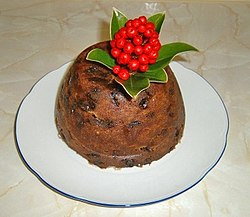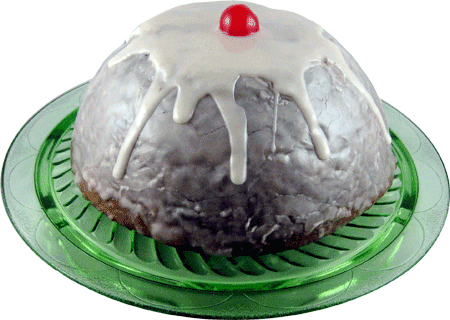Here's a bit of what I learned about the Puddin' via Wikipedia.
Basics
Many households have their own recipe for Christmas pudding, some handed down through families for generations. Essentially the recipe brings together what traditionally were expensive or luxurious ingredients - notably the sweet spices that are so important in developing its distinctive rich aroma, and usually made with suet. It is very dark in appearance - effectively black - as a result of the dark sugars and black treacle in most recipes, and its long cooking time. The mixture can be moistened with the juice of citrus fruits, brandy and other alcohol (some recipes call for dark beers such as mild, stout or porter).
 Prior to the 19th century, the English Christmas pudding was boiled in a pudding cloth, and often represented as round. The new Victorian era fashion involved putting the batter into a basin and then steaming it, followed by unwrapping the pudding, placing it on a platter, and decorating its top with a sprig of holly.
Prior to the 19th century, the English Christmas pudding was boiled in a pudding cloth, and often represented as round. The new Victorian era fashion involved putting the batter into a basin and then steaming it, followed by unwrapping the pudding, placing it on a platter, and decorating its top with a sprig of holly.Initial cooking usually involves steaming for many hours (the period can be shortened without loss of quality by using a pressure cooker). To serve, the pudding is reheated by steaming once more, and dressed with warm brandy which is set alight. It can be eaten with hard sauce, brandy butter, rum butter, cream, lemon cream, custard, or sweetened béchamel, and is sometimes sprinkled with caster sugar.
History
The plum pudding's association with Christmas goes back to medieval England with the Roman Catholic Church's decree that the "pudding should be made on the 25th Sunday after Trinity, that it be prepared with 13 ingredients to represent Christ and the 12 apostles, and that every family member stir it in turn from east to west to honor the Magi and their supposed journey in that direction".[1] Recipes for plum puddings appear mainly, if not entirely, in the 17th century and later. Their possible ancestors include savory puddings such as those in Harleian MS 279, crustades,[4] malaches whyte,[5] creme boiled (a kind of stirred custard), and sippets. Various ingredients and methods of these older recipes appear in early plum puddings.Features of these recipes were combined or refined in ways that could have yielded plum pudding recipes. For example, combining the stirred custard with sippets makes it into a fool, a contemporary of early plum puddings, which is very similar to a pudding. Some early custard tarts, such as the crustade lumbard in Harleian MS 279, are only unlike plum puddings in that they are held together by a pastry crust and not by crumbs or meal. Malaches whyte, another kind of pastry, has a filling of eggs, bread crumbs, and butter, but no plums. So a fully developed plum pudding recipe could be derived from the above list of possible ancestors by some recombination. This is not to say that there were no other ancestors, only that there need not have been any.
Although it took its final form in Victorian England, the pudding's origins can be traced back to the 1420s, to two sources. It emerged not as a confection or a dessert at all, but as a way of preserving meat at the end of the season. Because of shortages of fodder, all surpluses livestock were slaughtered in the autumn. The meat was then kept in a pastry case along with dried fruits acting as a preservative. The resultant large "mince pies" could then be used to feed hosts of people, particularly at the festive season. The chief ancestor of the modern pudding, however, was the pottage, a meat and vegetable concoction originating in Roman times. This was prepared in a large cauldron, the ingredients being slow cooked, with dried fruits, sugar and spices added. In the 15th century, Plum pottage was a sloppy mix of meat, vegetables and fruit served at the beginning of a meal.[6]
In 1714, King George I (sometimes known as the Pudding King) requested that plum pudding be served as part of his royal feast in his first Christmas in England. A recipe for "plum porridge" appeared in Christmas Entertainments in 1740.[1] As techniques for meat preserving improved in the 18th century, the savory element of both the mince pie and the plum pottage diminished as the sweet content increased. The mince pie kept its name, though the pottage was increasingly referred to as plum pudding. Although the latter was always a celebratory dish it was originally eaten at the Harvest Festival, not Christmas. It was not until the 1830s that the cannon-ball of flour, fruits, suet, sugar and spices, all topped with holly, made a definite appearance, becoming more and more associated with Christmas. In 1747, London food writer Hannah Glasse had given a recipe for Christmas plum porridge, but it appears that East Sussex cook Eliza Acton was the first to refer to it as "Christmas Pudding" in her cookbook.[7]




No comments:
Post a Comment